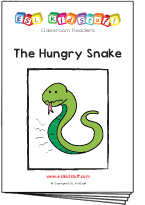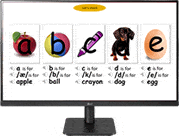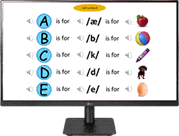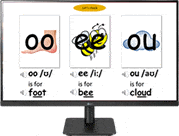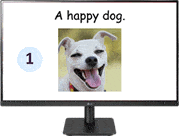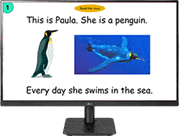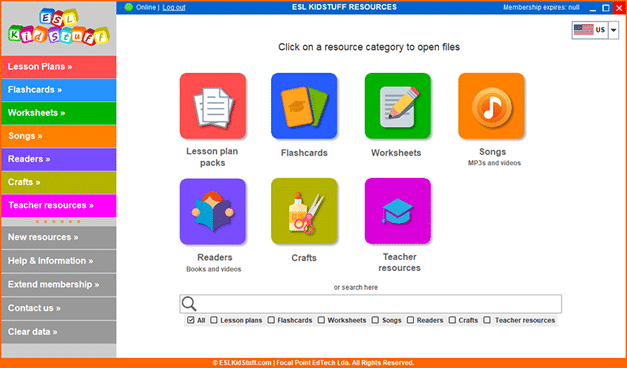Alphabet a-z (Level 1 beginners) lesson plan
Lowercase letters a-z
Level 1 (beginners) Age 5-12
Alphabet mini lessons for ESL kids teachers
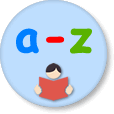
Alphabet a-z (lowercase)
These mini lessons focus on learning the lowercase letters of the alphabet. Students learn to [hide_on_uk]recognize[/hide_on_uk][hide_on_us]recognise[/hide_on_us] and write the individual letters. Phonetics are also introduced to allow students to sound out the letters correctly.
Members get accompanying flashcards, worksheets, reader and song.
Our lesson plans are FREE!
Sign up for accompanying:
✔ worksheets
✔ homework sheets
✔ flashcards
✔ PowerPoint lessons & multimedia
✔ song downloads & videos
✔ classroom readers & videos
Materials
Click to see lesson details, materials and supplies
Age: 5-12 years
Time: 10-15 mins
Objectives: Identify and recognize 3 lowercase letters per mini-lesson.
Lesson materials
Flashcards:
- Alphabet flashcards a-z (lowercase) – have the lowercase letter printed on one side of the flashcard and the corresponding image on the other side
Printables:
- Printing sheet for the 3 letters practiced
Songs:
- The ABC song
Readers:
- The alphabet book (for lesson 11)
Supplies:
- blackboard / whiteboard with chalk / markers
- device to play the song on
Use this mini-lesson plan within your main lesson for alphabet practice – teach 3 letters each lesson.
We strongly advise NOT dedicating a full lesson to the alphabet – we suggest including a 10-15-minute section each lesson for teaching and reviewing the alphabet. The full alphabet (lowercase first, then uppercase) should be taught over a series of lessons and reviewed each lesson. The number of letters you teach each lesson depends on the ability and age of your students.
We suggest teaching 3 letters per lesson for 5-year-olds and older, for students with no experience reading or writing the alphabet.
Lesson procedure:
Warm up and maintenance:

1. Sing “The ABC song”
Start this section of the lesson with the ABC song to indicate that it’s alphabet time. If possible, have the letters of the alphabet stuck around the walls of your classroom, high enough so your students can’t take the down, and point at each letter as it is sung. If not, it’s not a problem, sing along with the song and have fun.
Lyrics for “The ABC song“
Verse 1:
A B C D E F G
H I J K L M N
O P Q R S T U
V W and X Y Z
I can sing my ABCs,
Won’t you sing along with me?
Verse 2:
A B C D E F G
H I J K L M N
O P Q R S T U
V W and X Y Z
I can sing my ABCs,
Won’t you sing along with me?
[hide_on_uk]Short sample (members get full-length song):
[/hide_on_uk]
[hide_on_us]Short sample (members get full-length song):
[/hide_on_us]

2. Review the letters learned in previous lessons (lesson 2 “d e f” onwards)
Use your flashcards to quickly run through the letters learned in previous lessons, in alphabetical order. This should be a quick run through, eliciting each letter, sound and picture:
- Hold up the first letter and ask, “What’s this?” – elicit the letter (e.g. “a”)
- Then ask, “Is for?” – elicit the phonetic sound (e.g. “ah”)
- Finally, turn over the flashcard showing the picture and ask again, “Is for?” – elicit the word (e.g. “apple”)
- Continue with the rest of the letter flashcards
3. Introduce the letters with flashcards
For the new letters, follow this basic procedure. This section of the lesson should be fast paced and fun.
- Have everyone gather around you so they are close – have them sit on the floor with you, if possible. You want everyone to be close enough, so you can easily pass cards back and forth with them.
- Hold up an alphabet letter flashcard so all students can see it.
- Chorus the letter 3 to 5 times. Then ask each student individually to say the letter.
- Teach the sound of the letter (e.g. “a is for ‘ah’ … ah – ah – ah”). Chorus again and check individually.
- Provide an example of an object that begins with the letter. Double-sided flashcards with the letter on
one side and a picture on the other are great for this. (e.g. “What’s this?” (elicit “a”). “And a is for…?” (elicit “ah”). “And ‘ah’ is for … (turning the card over) “apple!”. Chorus the word and check individually. Therefore, a typical interaction for a single letter (covering points 2-5 above) would be as follows:
Teacher: (showing a flashcard of the letter a) “a .. a .. a .. repeat a”
Students: “a”
T: “a”
Ss: “a”
T: “a”
Ss: “a”
T: “a is for ah .. ah .. ah. Repeat ah”
Ss: “ah”
T: “ah”
Ss: “ah”
T: “ah”
Ss: “ah”
T: “a, is for ah, is for (turning the card over) apple .. apple .. apple .. repeat apple”
Ss: “apple”
T: “apple”
Ss: “apple”
T: “apple”
Ss: “apple”
T: “Good! What’s this?” (showing “a”)
Ss: “a”
T: “Is for?”
Ss: “ah”
T: “Is for?” (turning the card)
Ss: “apple”
T: “Well done!” (now asks individual students) - Do a final check:
Teacher: What’s this? (holding up the ‘a’ flashcard)
Students: ‘a’ T: And ‘a’ is for…?
Ss: ‘ah’
T: And ‘ah’ is for…?
Ss: ‘Apple! - Then move onto the next letter.
As you teach each letter, use a combination of the activities in 4 below to practice and reinforce each letter.

4. Do a combination of activities to practice the new letters
Below are some activities you can use each time to teach a new letter. Use different activities for each letter to keep things fun and interesting.
- Give and give back: Give the letter flashcard to a student and get him/her to say the letter, sound and picture before passing back to you. Then do the same with some other students.
- Pass it: Sit with your students in a circle. Hold up a flashcard letter and say the letter (e.g. “A”). Pass it on to the next student who also says it and passes it on to the next student.
- Write on the board: kids love writing on the blackboard or whiteboard. After teaching each letter, give a chalk / marker pen to a student and ask him/her to write the letter onto the board (as large as they can). You can have more than one student do this for each letter.
- Magic finger: Hold the flashcard letter up in front of each student and let them trace the letter on the card with their ‘magic’ finger. Then the teacher, using his/her magic finger, traces the letter in the air and the students follow suit. The teacher and the students can then use their magic fingers to trace the letter on all sorts of fun places. For example, “Draw ‘P’ on your hand. Now on the floor. Now on your partner’s back. Now on your cheek. Now on the wall. Now on your foot” etc.
5. Check the 5 letters
Do a quick final check of the 3 new letters:
- Hold up the first letter and ask, “What’s this?” – elicit the letter (e.g. “a”)
- Then ask, “Is for?” – elicit the phonetic sound (e.g. “ah”)
- Finally, turn over the flashcard showing the picture and ask again, “Is for?” – elicit the word (e.g. “apple”)
- Continue with the other 4 letters

6. Review letters with games
When you have finished teaching the 5 new letters you can play a series of games to reinforce these letters, mixed in with the letters your students have learned in previous lessons. Here are some popular games, rotate them so you have new games each week:
- Slow motion: Hold the pack of alphabet flashcards with the letters facing towards yourself. The first letter card should be turned around, so the letter is facing the students but is hidden as it is behind the pack. Slowly pull the flashcard up inch by inch so the students can only see part of the letter. As the letter is slowly revealed, students try to guess what it is. The first student to guess correctly keeps the card (for 1 point). Variation: to make it a little more difficult turn each letter flashcard upside down.
- Letter touch: Place the alphabet letter cards, face-up, on the floor. Students sit in a circle around the cards. Tell everyone to hold up their hands. The teacher then says a letter and the students must race to touch that letter first. The person who touches the letter first picks up the card and keeps it. At the end of the game, the student with the most letter cards is the winner.
- Vanishing alphabet flashcards: place the flashcard letters in front of your students, in the correct order. Tell everyone to close their eyes. Take away one of the flashcards and then tell your students to open their eyes again. The first student to shout out the missing letter can keep that flashcard. At the end of the game, the student with the most letter cards is the winner. Variation: to make it a little more difficult, lay the letter flashcards out in random order.
- Hold it up: Give out all the letter flashcards to students. Students can have more than one letter. Say a letter and the student holding that card must hold it up in the air. Variation: say different actions as well, which the student holding the card must do, e.g. “The student with card “D”, jump 5 times!”.
- Find it: Hold up a letter flashcard and the students search around the room for an object beginning with that letter. (e.g. A – arm, B – book, C – clock).
7. Read the words (after learning letters “a” to “o”)
Once students have learned the letters a-o, you can begin introducing short words for students to read and write. Start by writing the following words on the board, slowly, letter-by-letter, getting students to say the sounds for each letter as you write them. Then elicit the word. Here are some words you can use each lesson:
- Lesson k l m n o: jam, hen, leg, dog, bed, hand (review of a-o)
- Lesson p q r s t: red, pan, rag, pen, ten, sad
- Lesson u v w x y z: wet, up, yak, box, zip, vest
- Lesson a-z: jet, pig, hop, bus, fan, cat (review of a-z)
You may need to prepare pictures of some of the words and pre-teach them before writing the words on the board.
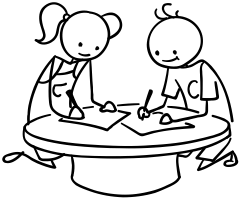
8. Do a letter practice worksheet
Give out a printing worksheet to each student to practice the new letters (download from our website before class). As students are doing the worksheets, circulate and ask individual students questions about the letters (what is this letter? “a”, What sound is it? “ah”. And what is the picture? “an apple”.)
Alternatively, set the printing sheet for homework and check in the next lesson.
Alphabet printing exercises are an important first step in learning to write. Printing exercises don’t have to be boring – they can be really fun! They should also help students to internalize the letters.
- Before the students begin printing, model each letter print showing the directions of the letter strokes.
- When printing letters, get students to call out each letter as they write it.
- If writing lower and uppercase have your students say “big ‘A’, small ‘a'” as they write.
- Let students write letter sets in different colors and allow students to draw little pictures on their printing sheets.
- Continuously monitor the students while they print, helping with letter strokes, spaces between each letter, letter size, etc. Also, while monitoring, point to letters the students have already printed and ask them what they are.
- Encourage students to circle their best printing effort for each letter set.
- Finish by holding up each student’s sheet, asking questions (“what is this letter?”) pointing out any mistakes, etc., but above all give lots of praise and encouragement!
Other lesson plans
Levels:
Level 1 lessons (Age 3-5)
Level 2 lessons (Age 5-7)
Level 3 lessons (Age 7-9)
Level 4 lessons (Age 9-12)
Mini lessons (all ages)
Mini lessons:
1. Alphabet a-z (Level 1 beginners):
2. Alphabet a-z (Level 2 early starters):
Alphabet a-z lowercase
3. Alphabet A-Z (Levels 1 & 2):
Alphabet A-Z uppercase
4. Letter clusters + phonics:
Letter clusters
5. Early reading:
Funny sentences
6. Reading short texts:
Short texts reading & writing



